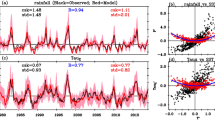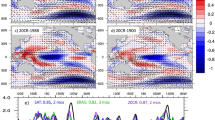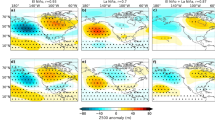Abstract
Over the past two decades, El Niño events have weakened on average and their sea surface temperature (SST) anomalies shifted westward towards the central Pacific. Moreover, the intertropical convergence zone (ITCZ), which typically migrates southward from its northerly position during El Niño events, has not crossed the Equator since 1998. The causes of these changes remain under debate1,2,3,4,5. Here, using in situ, satellite and atmospheric reanalysis data, we show they can be related to a multidecadal strengthening of cross-equatorial winds in the eastern Pacific. This gradual strengthening of meridional winds is unlikely to be caused by El Niño/Southern Oscillation (ENSO) changes, and contains signals forced both locally and from outside the tropical Pacific, probably from the tropical North Atlantic. Coupled model simulations in which the observed cross-equatorial wind strengthening is superimposed successfully reproduce the key features of the recent changes in tropical climate. In particular, the tropical mean state experiences a ‘La Niña-like’ change, the ENSO amplitude weakens by about 20%, the centre of the SST anomalies shifts westward and the ITCZ now rarely crosses the Equator. Thus, cross-equatorial winds are found to modulate tropical Pacific mean state and variability, with implications for quantifying projected changes in ENSO under anthropogenic warming.
This is a preview of subscription content, access via your institution
Access options
Access Nature and 54 other Nature Portfolio journals
Get Nature+, our best-value online-access subscription
$29.99 / 30 days
cancel any time
Subscribe to this journal
Receive 12 print issues and online access
$209.00 per year
only $17.42 per issue
Buy this article
- Purchase on Springer Link
- Instant access to full article PDF
Prices may be subject to local taxes which are calculated during checkout




Similar content being viewed by others
References
Ashok, K., Behera, S. K., Rao, S. A., Weng, H. Y. & Yamagata, T. El Niño Modoki and its possible teleconnection. J. Geophys. Res. Oceans 112, C11007 (2007).
Kao, H. Y. & Yu, J. Y. Contrasting eastern-Pacific and central-Pacific types of ENSO. J. Clim. 22, 615–632 (2009).
Kug, J. S., Jin, F. F. & An, S. I. Two types of El Niño events: cold tongue El Niño and warm pool El Niño. J. Clim. 22, 1499–1515 (2009).
Yeh, S. W. et al. El Niño in a changing climate. Nature 461, 511–514 (2009).
McPhaden, M. J., Lee, T. & McClurg, D. El Niño and its relationship to changing background conditions in the tropical Pacific Ocean. Geophys. Res. Lett. 38, L15709 (2011).
Fedorov, A. V. & Philander, S. G. Is El Niño changing? Science 288, 1997–2002 (2000).
McPhaden, M. J., Zebiak, S. E. & Glantz, M. H. ENSO as an integrating concept in Earth science. Science 314, 1740–1745 (2006).
Collins, M. et al. The impact of global warming on the tropical Pacific Ocean and El Niño. Nat. Geosci. 3, 391–397 (2010).
Cai, W. et al. Increasing frequency of extreme El Niño events due to greenhouse warming. Nat. Clim. Change 4, 111–116 (2014).
Cai, W. et al. ENSO and greenhouse warming. Nat. Clim. Change 5, 849–859 (2015).
Capotondi, A. & Sardeshmukh, P. D. Is El Niño really changing? Geophys. Res. Lett. 44, 8548–8556 (2017).
Yeh, S. W. et al. ENSO atmospheric teleconnections and their response to greenhouse gas forcing. Rev. Geophys. 56, 185–206 (2018).
Hu, S. & Fedorov, A. V. Exceptionally strong easterly wind burst stalling El Niño of 2014. Proc. Natl Acad. Sci. USA 113, 2005–2010 (2016).
Levine, A. F. Z. & McPhaden, M. J. How the July 2014 easterly wind burst gave the 2015–2016 El Niño a head start. Geophys. Res. Lett. 43, 6503–6510 (2016).
Hu, S. & Fedorov, A. V. The extreme El Niño of 2015–2016: the role of westerly and easterly wind bursts, and preconditioning by the failed 2014 event. Clim. Dynam. https://doi.org/10.1007/s00382-017-3531-2 (2017).
Puy, M. et al. Influence of westerly wind events stochasticity on El Niño amplitude: the case of 2014 vs. 2015. Clim. Dynam. https://doi.org/10.1007/s00382-017-3938-9 (2017).
Santoso, A., McPhaden, M. J. & Cai, W. The defining characteristics of ENSO extremes and the strong 2015/16 El Niño. Rev. Geophys. 55, 1079–1129 (2017).
England, M. H. et al. Recent intensification of wind-driven circulation in the Pacific and the ongoing warming hiatus. Nat. Clim. Change 4, 222–227 (2014).
Capotondi, A. et al. Understanding ENSO Diversity. Bull. Am. Meteorol. Soc. 96, 921–938 (2015).
Wittenberg, A. T. Are historical records sufficient to constrain ENSO simulations? Geophys. Res. Lett. 36, L12702 (2009).
Xie, S. P. & Philander, S. G. H. A coupled ocean-atmosphere model of relevance to the ITCZ in the Eastern Pacific. Tellus A 46, 340–350 (1994).
Li, X., Xie, S. P., Gille, S. T. & Yoo, C. Atlantic-induced pan-tropical climate change over the past three decades. Nat. Clim. Change 6, 275–279 (2016).
Enfield, D. B., Mestas‐Nuñez, A. M. & Trimble, P. J. The Atlantic multidecadal oscillation and its relation to rainfall and river flows in the continental US. Geophys. Res. Lett. 28, 2077–2080 (2001).
Chiang, J. C. H. & Friedman, A. R. Extratropical cooling, interhemispheric thermal gradients, and tropical climate change. Ann. Rev. Earth Planet. Sci. 40, 383–412 (2012).
Frierson, D. M. & Hwang, Y. T. Extratropical influence on ITCZ shifts in slab ocean simulations of global warming. J. Clim. 25, 720–733 (2012).
Li, G. & Xie, S. P. Tropical biases in CMIP5 multimodel ensemble: the excessive equatorial Pacific cold tongue and double ITCZ problems. J. Clim. 27, 1765–1780 (2014).
Philander, S. G. H. & Pacanowski, R. C. The oceanic response to cross-equatorial winds (with application to coastal upwelling in low latitudes). Tellus 33, 201–210 (1981).
Lübbecke, J. F. & McPhaden, M. J. Assessing the twenty-first-century shift in ENSO variability in terms of the Bjerknes stability index. J. Clim. 27, 2577–2587 (2014).
Timmermann, A. et al. The influence of a weakening of the Atlantic meridional overturning circulation on ENSO. J. Clim. 20, 4899–4919 (2007).
Levine, A. F., McPhaden, M. J. & Frierson, D. M. The impact of the AMO on multidecadal ENSO variability. Geophys. Res. Lett. 44, 3877–3886 (2017).
Cheng, W., Chiang, J. C. H. & Zhang, D. X. Atlantic Meridional Overturning Circulation (AMOC) in CMIP5 Models: RCP and historical simulations. J. Clim. 26, 7187–7197 (2013).
Rahmstorf, S. et al. Exceptional twentieth-century slowdown in Atlantic Ocean overturning circulation. Nat. Clim. Change 5, 475–480 (2015).
Sevellec, F., Fedorov, A. V. & Liu, W. Arctic sea-ice decline weakens the Atlantic Meridional Overturning Circulation. Nat. Clim. Change 7, 604–610 (2017).
Xie, S. P. et al. Global warming pattern formation: sea surface temperature and rainfall. J. Clim. 23, 966–986 (2010).
Wang, H., Xie, S. P., Tokinaga, H., Liu, Q. & Kosaka, Y. Detecting cross-equatorial wind change as a fingerprint of climate response to anthropogenic aerosol forcing. Geophys. Res. Lett. 43, 3444–3450 (2016).
Giese, B. S. & Ray, S. El Niño variability in simple ocean data assimilation (SODA), 1871–2008. J. Geophys. Res. Oceans 116, C02024 (2011).
Fedorov, A. V., Hu, S. N., Lengaigne, M. & Guilyardi, E. The impact of westerly wind bursts and ocean initial state on the development, and diversity of El Niño events. Clim. Dynam. 44, 1381–1401 (2015).
Deser, C. et al. ENSO and Pacific decadal variability in the Community Climate System Model Version 4. J. Clim. 25, 2622–2651 (2012).
Capotondi, A. ENSO diversity in the NCAR CCSM4 climate model. J. Geophys. Res. Oceans 118, 4755–4770 (2013).
Manabe, S. & Stouffer, R. J. Two stable equilibria of a coupled ocean–atmosphere model. J. Clim. 1, 841–866 (1988).
Liu, W., Liu, Z. Y. & Brady, E. C. Why is the AMOC monostable in coupled general circulation models? J. Clim. 27, 2427–2443 (2014).
Vega-Westhoff, B. & Sriver, R. L. Analysis of ENSO’s response to unforced variability and anthropogenic forcing using CESM. Sci. Rep. 7, 18047 (2017).
Taylor, K. E., Stouffer, R. J. & Meehl, G. A. An overview of CMIP5 and the experiment design. Bull. Am. Meteorol. Soc. 93, 485–498 (2012).
Acknowledgements
This research was supported by grants to A.V.F. from the NSF (AGS- 0163807) and NASA (NNX17AH21G). S.H. was supported by a NASA Earth and Space Sciences Graduate Fellowship, and a Scripps Institutional Postdoctoral Fellowship. We also acknowledge computational support from the Yale University Faculty of Arts and Sciences High Performance Computing facility and from the NSF/NCAR Yellowstone Supercomputing Center.
Author information
Authors and Affiliations
Contributions
S.H. and A.V.F. contributed equally to designing the research and writing the manuscript. S.H. performed the data analysis and numerical simulations and, together with A.V.F., interpreted the results.
Corresponding author
Ethics declarations
Competing interests
The authors declare no competing interests.
Additional information
Publisher’s note: Springer Nature remains neutral with regard to jurisdictional claims in published maps and institutional affiliations.
Supplementary information
Supplementary Information
Supplementary figures 1–11
Rights and permissions
About this article
Cite this article
Hu, S., Fedorov, A.V. Cross-equatorial winds control El Niño diversity and change. Nature Clim Change 8, 798–802 (2018). https://doi.org/10.1038/s41558-018-0248-0
Received:
Accepted:
Published:
Issue Date:
DOI: https://doi.org/10.1038/s41558-018-0248-0
This article is cited by
-
Intensification of Pacific tropical instability waves over the recent three decades
Nature Climate Change (2024)
-
Historical changes in wind-driven ocean circulation drive pattern of Pacific warming
Nature Communications (2024)
-
Vertical structure of low-level cross-equatorial flows in boreal summer
Theoretical and Applied Climatology (2024)
-
Enhanced impact of the Aleutian Low on increasing the Central Pacific ENSO in recent decades
npj Climate and Atmospheric Science (2023)
-
ENSO complexity controlled by zonal shifts in the Walker circulation
Nature Geoscience (2023)



